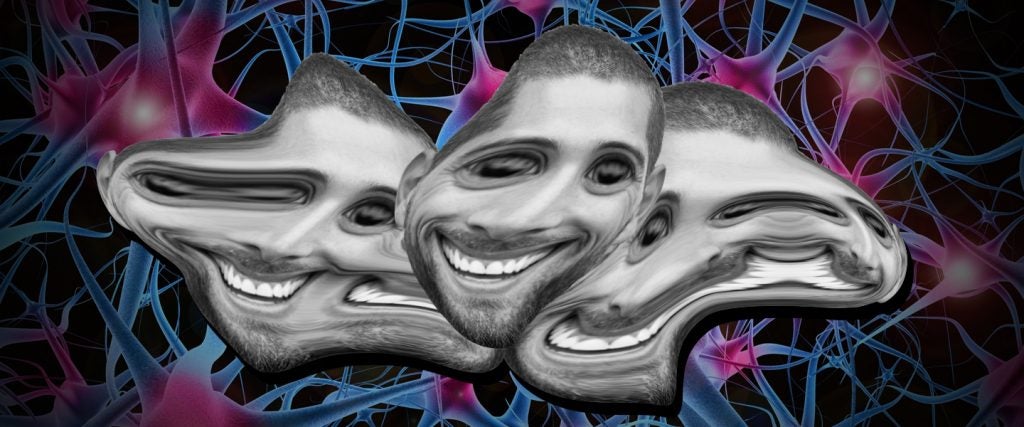On November 14, 2021, 26-year-old Felix, a pseudonym, made the following entry on their blog: “My head feels so heavy and floppy, my fingertips are numb, it’s like my brain is immensely heavy and floating in the middle of my skull, not touching anything, just drawing in its surroundings with a sundering gravitational force.”
They’re recalling their experience of taking 3,4-MD-PCP, a new dissociative drug they sourced through a well-connected friend. “It’s an amorphous compound that molds itself to all sorts of situations,” they continue. “At times it felt sentient, like I was engaging in a complex interplay with some other being or some creature, curious and alive and fully interactive. It’s my colorful, dissociative little pet.”
Felix was watching King of the Hill with their partner — and simultaneously playing Minecraft — when they snorted 40 milligrams of the drug. They smoked a little weed as they began to come up. Half an hour later, they started to fully feel the 3,4-MD-PCP’s effects washing over them — it was the “same sensation as lying in the ocean and having its waves buffet [their] head.” They started to see visuals — “dense networks of roots and mycelium twisting and turning at right angles, translucent and gelatinous” — and, as they walked, it felt like their limbs no longer belonged to them. An hour and a half after snorting the powder, Felix returned to the world “imbued with a glowing energy,” having spent the previous hour lying down in the total dark listening to Oneohtrix Point Never’s Garden of Delete. Still, it took four more hours to return to baseline.
The 3,4-MD-PCP was just one of 43 different types of drugs Felix — who goes by the internet pseudonym Nervewing (and uses they/them pronouns) — took last year. It’s more than they’ve ever used before in their life, and more than most amateur psychonauts like them can claim. “I cannot maintain a lifestyle like this forever,” they recently wrote on their blog in an annual review of their year in drugs. “The human body and mind simply are not meant to. But I love every second of it and, as it stands, I likely won’t stop until my hand is forced in some way.”
Felix has several reasons for their near-constant drug taking. First, they tell me, they aim to use substances to “serve my life, whether it be therapeutically, creatively or to enrich it with exciting and novel experiences.” Second, simply to explore the wide variety of drugs that exist. And third, “to contribute to humanity’s knowledge on substances.”
It’s the latter that incentivizes Felix to meticulously document their experiences via their blog, as well as on Reddit’s r/ResearchChemicals, where tens of thousands of users congregate to discuss synthetic psychoactive research chemicals, also known as novel psychoactive substances (NPS). On the subreddit, you’ll find people asking for advice before taking a new substance for the first time, sharing their stories of combos that worked, looking for intel as to why others didn’t or even just volunteering their reviews of a particular drug. Unlike other forums like r/Drugs, where people typically ask for advice about more common substances — magic mushrooms, LSD, MDMA, cocaine, ketamine and weed — the NPS psychonauts are searching for “analogues” of drugs, with names like the aforementioned 3,4-MD-PCP (the “most interesting drug” Felix took in 2021) or 1cP-AL-LAD (“a delightful psychedelic”).
“Drugs fall into a bunch of different families based on the structure of the molecule,” Felix explains. “Just about everything I’ve tried falls into a few major categories of drug, and within each of these categories, you can vary the basic formula a little to produce some drug that’s similar, but slightly different in some way.” Some of Felix’s favorite drug families are phenethylamines (e.g., 2C-B, methamphetamine), tryptamines (DMT, psilocybin), lysergamides (LSD), dissociatives (ketamine, PCP) and benzodiazepines (Xanax). “All of the drugs I like to explore can be seen as analogues to these classes — variations in some way,” they continue. “Some are almost indistinguishable from the ones you mentioned, and some are structurally related, but have wildly different effects.”
Not a huge amount is known about NPS — also commonly referred to as “designer drugs” — except, according to a 2020 study, that they’re likely to go undetected by routine drug tests, and that they entered the mainstream around 2009. Because of this, most people — including scientists and doctors — get their information about them online, making Felix’s diligent diary entries even more significant. Last month, a study into the potentially harmful or lethal outcomes of NPSs concluded that online forums like Reddit “can help predict changes in exposures associated with new or re-emerging novel psychoactive substances in the real world.”
Toxicologist Roy Gerona and the other scientists in his San Francisco-based lab spend hours trawling these forums to help them develop their “library of designer drugs.” The library was most notably used to identify what was in 24 Karat Gold, the synthetic marijuana that hospitalized 33 people in Brooklyn in July 2016. Although they haven’t been informed of their research yielding anything of particular use for academics (as of yet), Felix says they’ve seen their reports cited in articles about drug design, and has written some themself.
Research into these drugs is an effective method of harm reduction for those taking them, whether conducted by academic or non-academic psychonauts. As journalist Angela Chen observed in a 2017 article for The Verge, “designer drugs are volatile. If you tweak just one molecule, you can get an entirely different substance, one you hadn’t bargained for.” On their blog, Felix details the adverse effects of some of their 2021 substances, including a psychotic episode on a mix of 3-MeO-PCP, MXPr, Pyrazolam and Flualprazolam, being tossed into “the depths of withdrawal the moment [Flunitrazolam] wore off, feeling jittery and overstimulated,” and not being able to keep food down for two days after taking buprenorphine. But, they say, none of these side effects were worse than what they’ve previously experienced. Other r/ResearchChemicals users have fared worse, with some telling cautionary tales of kidney failure, bad trips and erectile dysfunction.
With all this in mind, Felix says that seeing academics studying NPS is “super exciting.” They’ve been interested in drugs since their teenage years, ironically via America’s D.A.R.E. program, which seeks to prevent use of controlled substances, among other things. “I was always driven by imagination, and them telling me that there were drugs that could make you see things that aren’t there… that just sounded amazing,” they say. After smoking weed in high school, they quickly went on to try LSD and magic mushrooms — the latter of which they say “set the trajectory for the rest of my life.”
Alongside r/ResearchChemicals, Felix has learned most of what they know from internet communities, nonprofits like Erowid — an educational and harm-reduction resource — word-of-mouth and online vendors, as well as through the limited scientific and medical literature available and the works of the late chemist Alexander Shulgin.
Shulgin, the “godfather of psychedelics,” who passed away in 2014 at the age of 88, is credited with introducing MDMA to psychologists in the late 1970s (he wasn’t the first to synthesize it, but he found a novel way to do it). He also discovered psychoactive compounds such as 2C-B and DOM. Like Felix, Shulgin personally experimented with hundreds of psychedelics and their analogues, but — unlike Felix — he was also able to synthesize his own after being granted a license for an analytical laboratory (he’d done previous work in psychopharmacology). In scrupulous detail, Shulgin recorded the effects of the seemingly infinite number of slight chemical variations of substances, a legacy continued by modern psychonauts like Felix. While most of them aren’t synthesizing the drugs themselves, their personal testing and experimentation of combinations is building on Shulgin’s work, and could one day lead to the discovery of another globally known and taken substance like MDMA.
Alongside their academic reading, Felix also sought education about research chemicals from 4chan, which is where they discovered the dark web drug market Silk Road and bought their first “strange compounds.” When I ask where they source their substances today, Felix understandably warns me that they “can’t be too specific,” but says that “through pure luck,” they met a friend who “invested a lot in crypto and could seamlessly navigate the world of the dark web markets.” Thanks to the instability of the dark web, they say there’s less diversity of substances available there, so they also look to vendors who sell “quasi-legal compounds” on regular-looking websites (Felix explains that the substances tend to be legal in certain jurisdictions, and buyers pay with crypto), as well as to online communities, who sell to each other.
When shopping around, Felix is looking to try any psychedelics, dissociatives and benzos that they haven’t tried before. “I try to try everything I can obtain — even ones that don’t have the best reviews,” they explain. “I’m even more excited to try ones with little data existing on them so that I can contribute to that data pool.” They say they aren’t particularly interested in stimulants, like research chemicals meant to imitate MDMA, nor cannabinoids or opioids.
In terms of how these compounds get made, Felix confirms that they aren’t involved in the production of the substances they take, and doesn’t believe universities or other specialist institutions are either. Instead, they say, the substances are made in labs around the world — some are clandestine home productions, while others are produced on an industrial scale as part of the “regular processes of chemical manufacturing companies in countries where the product is legal.”
When I ask Felix if they can estimate how much money they’ve spent on these drugs in the last year alone, they say, “I don’t want to think about it. I don’t even know. Sometimes it’s worth it, and sometimes it isn’t — it’s a gamble.” (Although they ask me not to disclose what they do for a living, they say it supports both their living costs and the costs of the drugs.) I also wonder what effect such a concoction has had on their mental health. “I was never mentally healthy from the start,” Felix explains. “Whether doing drugs made it better or worse is impossible to say. All I can say today is that I’m still alive, I mostly have my symptoms [of Borderline Personality Disorder] under control and I have a stable relationship and employment and a place to live. Something worked ultimately, but it was an extremely tumultuous and difficult road and I would never in good conscience suggest anyone else go about it in the same way.”
Nevertheless, Felix continues to experiment with novel psychoactive substances. This year, they’ve already documented their experience with 3C-P (the amphetamine analogue of procaline, which in turn is an analogue of mescaline — itself the first hallucinogenic drug that Shulgin took). They describe it on their blog as “pretty mild” but “fun, stimulating, warm and articulate.” And, they assure me, there are plenty more experiences to come. Or as they put it, “Cheers to another year off-base from reality.”

